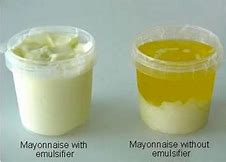ChatGPT said: The history of emulsifiers in food and cosmetic industries
Emulsifiers: Secret Active Ingredients for Accomplishing Completely Blended Formulas
Emulsifiers play an essential function in developing steady blends of immiscible liquids, such as oil and water. Their special properties permit them to lower surface area stress, which is crucial for uniformity in different solutions. Understanding the differences between all-natural and artificial emulsifiers can affect product high quality substantially. As markets increasingly seek to enhance structure and service life, the selection process for the appropriate emulsifier ends up being extremely important. What variables should be considered in this vital option?
Comprehending Emulsifiers: What They Are and Exactly how They Work
Although emulsifiers may appear like a straightforward addition to solutions, they play a crucial role in maintaining mixtures of components that commonly do not blend well, such as oil and water. These compounds function by lowering surface stress at the user interface in between immiscible liquids, permitting them to mix more uniformly. Emulsifiers have both hydrophilic (water-attracting) and lipophilic (oil-attracting) residential properties, which enable them to anchor themselves at the limit of the two phases. By doing so, they create a protective obstacle that prevents the beads of one fluid from integrating right into larger masses, thereby maintaining a steady emulsion. The effectiveness of an emulsifier depends upon its molecular framework, which affects its capacity to support combinations. In numerous applications, from foodstuff to cosmetics, emulsifiers ensure a constant structure and look, improving both capability and consumer charm. Their importance can not be overstated in achieving well-blended formulas.
Kinds of Emulsifiers: Artificial vs. natural
Emulsifiers can be extensively categorized into 2 kinds: all-natural and synthetic, each offering unique advantages and applications. All-natural emulsifiers, originated from plant or pet sources, include lecithin, casein, and gum arabic (emulsifiers). These emulsifiers are frequently preferred in natural and clean-label products as a result of their marginal handling and biocompatibility. Their mild nature makes them ideal for sensitive formulas, specifically in food and cosmetics

On the other hand, artificial emulsifiers such as mono- and diglycerides, and polysorbates are produced via chemical procedures. They are frequently utilized in industrial applications as a result of their security and performance in creating solutions. Synthetic emulsifiers often show remarkable efficiency in severe problems, such as heats or varying pH levels. The selection between synthetic and natural emulsifiers greatly depends on the details solution demands, regulatory considerations, and customer preferences, affecting their reliable application in various industries.
Functions of Emulsifiers in Food and Aesthetic Solutions
The duty of emulsifiers prolongs past plain stabilization; they are basic in achieving the desired appearance, texture, and rack life of food and cosmetic products. In food formulations, emulsifiers assist mix oil and water, developing consistent and smooth appearances crucial for sauces, dressings, and dairy items. They decrease surface area stress, improving the security of solutions, which protects against separation and prolongs freshness.
In cosmetics, emulsifiers assure that components, such as oils and water, mix effortlessly, giving a pleasant feeling and boosting application. emulsifiers. They add to the item's thickness and spreadability, vital for creams, lotions, and lotions. Furthermore, emulsifiers can envelop active ingredients, enhancing their circulation and efficiency in formulations. By regulating appearance and boosting sensory characteristics, emulsifiers play a vital role in conference customer assumptions in both food and cosmetic industries, assuring items are not just attractive but also functionally efficient
Selecting the Right Emulsifier for Your Product

In addition, the target application-- whether for food, cosmetics, or drugs-- will certainly influence the choice. Food-grade emulsifiers need to comply with security regulations, while aesthetic emulsifiers may call for skin helpful hints compatibility. Reviewing aspects such as HLB (Hydrophilic-Lipophilic Equilibrium) aids in anticipating emulsifier actions in particular solutions. Inevitably, a comprehensive analysis of both functional demands and governing factors to consider is necessary to select one of the most efficient emulsifier, making certain the final product satisfies the preferred quality and stability requirements.

Tips for Effective Emulsion Development and Security
Attaining effective emulsion development and stability needs mindful focus to a number of vital elements. Initially, the option of emulsifier plays a critical function; it should be compatible with the oil and water stages to ensure efficient stabilization. Second, the ratio of oil to water have to be balanced, as an improper proportion can result in instability. Third, the blending process needs to be controlled; high shear mixing can aid accomplish smaller sized droplet dimensions, improving security.
Temperature likewise influences emulsion security; preserving optimal temperature levels during solution protects against early splitting up. Additionally, incorporating stabilizers such as thickeners can further boost viscosity, lowering the possibility of stage separation. Finally, conducting thorough stability tests after formula will assist recognize potential problems, enabling adjustments prior to final manufacturing. By adhering to these standards, formulators can accomplish regular and trusted solutions that keep their wanted properties in time.
Frequently Asked Concerns
Can Emulsifiers Be Utilized in Vegan Formulations?
Yes, emulsifiers can be used in vegan formulations. Several plant-based emulsifiers, such as lecithin from soy or sunflower, offer reliable blending without animal-derived active ingredients, making them ideal for a range of vegan products.
What Prevail Allergens in Emulsifiers?
Common allergens look at this site in emulsifiers include soy, dairy, and eggs, as specific emulsifiers are originated from these sources. In addition, some people might react to additives or chemicals used along with emulsifiers in various formulas.

Just How Do Emulsifiers Influence Shelf Life of Products?
Emulsifiers improve item Read Full Article security by stopping splitting up of ingredients, thus prolonging service life. They alleviate spoilage triggered by microbial development and oxidation, causing prolonged freshness and improved top quality in various food and cosmetic formulas.
Exist Any Wellness Issues Linked With Emulsifiers?
Research study indicates possible health and wellness problems related to emulsifiers, including gut microbiome changes and inflammation. While regulatory bodies typically deem them secure, ongoing studies remain to discover lasting effects on wellness and total wellness.
Can Emulsifiers Improve Flavor or Fragrance in Formulations?
Emulsifiers can enhance flavor and fragrance in formulations by enhancing active ingredient dispersion and stability. This leads to an extra uniform product, permitting tastes to meld successfully, inevitably resulting in a more satisfying sensory experience for consumers.
Emulsifiers might appear like a basic addition to solutions, they play an important role in stabilizing combinations of ingredients that typically do not blend well, such as oil and water. In food formulas, emulsifiers aid blend oil and water, developing uniform and smooth appearances vital for sauces, dressings, and milk products. Food-grade emulsifiers need to abide with safety regulations, while cosmetic emulsifiers might require skin compatibility. Usual irritants in emulsifiers include soy, milk, and eggs, as certain emulsifiers are acquired from these resources. Emulsifiers can improve taste and aroma in formulations by enhancing component dispersion and security.